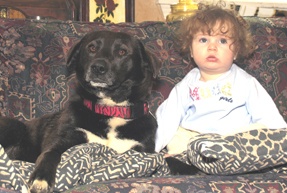
About 15-20 days ago I posted an article on “Teaching Kids How To Behave Around Dogs“, particularly when there has been no dog in the house previously. Well, the same holds true when you have a dog with no children, and the situation will be changing.
If you are expecting a new baby, now is the time to start training your dog to behave around children. Before you bring home your newborn, you know that there will be modifications to feeding and walking schedules for the dog so it is a good idea to transition into those changes in advance. The dog will also have more time to adjust to the new addition if the nursery and baby items are introduced before the big arrival.
Training Your Dog to Behave Around Children
Dogs will adjust to having children around much better if they are already well trained in basic commands. Your dog should respond consistently to sit, stay, down and leave it. Mastering these commands tells you that your dog listens and obeys you all the time.
Petco.com offers this insight into how a dog perceives a small child within the context of the typical pack mentality of canines.
Children often have a more difficult time establishing and holding their position in the pack, at
least in the dog’s eyes. A dog is often eye level with a toddler, and this can be frightening to
both him and the child. Or, he may view the child as a littermate, equal to him in height and
social position. He may feel he has the right to discipline the child when he or she tries to take
his food or toy, or plays too rough. Training both the dog and the child is essential to ensure
safety and happiness.
Babies and children are grabby and noisy and move in sudden bursts that might startle a dog or cause him to bark or growl. To prevent your dog from reacting in this manner you should begin by slowly conditioning him to the way children touch and the sounds that little ones make. Crying, screaming, laughing, tugging, hugging(squeezing) scratching, and poking are common ways that children behave around animals so any dog that will be around children needs to get used to these activities.
Before the new baby comes you can easily give your dog some special “training” to help prepare him. If your friends or relatives have well behaved, gentle kids it’s time to invite them over to meet your dog. Make sure everyone is aware and comfortable with the situation and that there is constant supervision. Have some treats on hand to reward your dog during and after the session with the kids, let him know good things happen when kids are around. A few healthy treats for the kids would be nice too!
When children gather at parks and playgrounds where they are in full active play, they are freely running, chasing, yelling, jumping. This kind of exposure is great for allowing your dog to recognize normal child behaviors and teaches him how to safely interact with them.
If you notice that your dog is extremely uncomfortable or starts barking or behaving aggressively, remove the dog and try less intense surroundings first. If your dog isn’t ready for the playground yet then start by acting silly, noisy and playful at home by running around the house or putting music or television on and dancing or jumping playfully. Offer treats and praise to reinforce good behavior.
I think one of the most important tips to remember when training your dog to behave around children, is to continue to give your dog love and attention when the new baby comes. Remain diligent with structure and discipline but don’t scold or punish harshly or neglect to provide the usual cuddles and kisses. Don’t give him a reason to feel jealous or anxious even though he has essentially taken a step down in his position in the pack. There is enough love to go around.
Several of you have experienced this situation. How did you handle it, and how did it work for you? Share your comments below.



